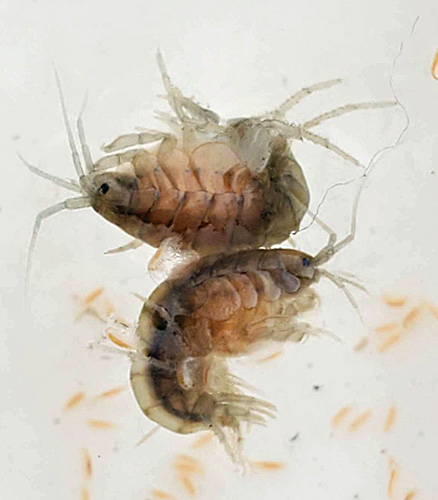
A Giant Casemaker Caddisfly next to its case.
Photo by Amy Ulland
Cold temperatures and snow on March 12 couldn’t dissuade a small, but dedicated band of our Stream Team volunteers from monitoring two sites on a tributary of Limestone Branch at JK Black Oak Wildlife Sanctuary. The team was rewarded for their efforts by finding some unusual specimens, including two Giant Casemaker Caddisflies, two scuds releasing their young and numerous copepods.
The Giant Casemaker Caddisfly produces silk from a gland under its chin, which is used to secure natural materials (in this case fallen leaves) into a portable case that provides protection and camouflage. Named “Giant” because its case can be up to an inch and a half long, this macro is definitely one of the bigger finds in a collection net.

Two female scuds in the process of releasing their young.
Photo by Amy Ulland
The scud is a type of crustacean that is often called a “side-swimmer” based on its manner of movement. The female scud has a brood pouch located on the underside of her thorax, where up to several hundred fertilized eggs develop. When the eggs mature into very small orange adult scuds, they are released by the female the next time she molts.
Our monitors collected another type of aquatic crustacean called a copepod. A copepod is usually 1 to 2 mm in length, just barely big enough to be caught in the 1/32” collection net. It has a translucent exoskeleton with a single compound eye, which is usually bright red and in the middle of its head.

A copepod with attached egg sac.
Photo by Emily Maltman
The upstream site, in the northeastern corner of the property, received a score of 7 out of 12, indicating unacceptable ecological conditions. The macro collection included a wide range of critters from pollution-sensitive beetles and mayflies to the pollution-tolerant worms and midges.
The downstream site received a score of 2 out of 12, indicating very unacceptable ecological conditions. Most macros collected here included pollution-tolerant leeches, worms, midges and lunged snails. This site is downstream from a malfunctioning wastewater treatment plant that has been releasing sewage solids into the stream.
The Environmental Protection Agency mandated that the owners of this plant construct a new treatment plant within the next year, and we are hopeful that once this new facility is up and running the stream conditions will improve.
To protect the environmentally sensitive habitat and rare species, JK Black Oak Wildlife Sanctuary is not open for general public access.

